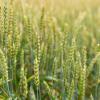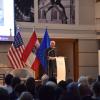
The BrightSpace Project funded under Horizon Europe brings together partners from across Europe, including IIASA, to design a roadmap for effective and sustainable strategies for assessing and addressing the challenges of EU agriculture to navigate within a safe and just operating space.
The increasingly worrisome events due to climate change highlight the fact that the future of humanity fundamentally depends on how we can manage the earth's resources and our environment in a way that their use does not cause an irreversibly unfavorable situation. The European Green Deal aims, among others, to increase the contribution of EU agriculture to climate change action, improve the management of natural resources, ensure a fair economic return for farmers, and reinforce the protection of biodiversity. EU agriculture and food practices are currently not on the right track to meet the Green Deal ambitions and objectives.
To address this, it is important to have tools that help create harmony between environmental constraints and economic goals. The aim of the BrightSpace project is to create simulation models in the field of agriculture and the food industry to help policymakers manage a balance between the economy and the environment.
Effective and sustainable strategies to navigate within a safe and just operating space
What is the concept of the BrightSpace project? The project is based on the "Safe and Just Operational Space" (SJOS) concept (Raworth, 2012), in which the safe component represents the biophysical boundaries of the ecosystem, and the fair component represents the wellbeing needs of people. The role of society and politics is twofold: it must help to reduce the gaps in the figure on the inner circular arc, by correcting the factors that overshoot towards the center, while preventing ecological overshoot.
The basic idea of the project is to produce scenarios based on public policies, institutional and social reforms, as well as possible technological development, which represent the development paradigms of humanity using complex modeling tools examining the agri-food sector. To evaluate these scenarios, easy-to-understand indicators for economic performance (e.g., income, agricultural production, and food prices), social performance (e.g., diet and agricultural employment) and environmental impacts (e.g., agricultural and forestry land use, greenhouse gases, and soil erosion) will be used.
The simulation models used in the project provide an opportunity to examine the economic and environmental impacts together. Among them are those that depict European agricultural markets in great detail, but there are also special land use and forest management models, and one model specifically examines the role of agriculture within the macro economy. By combining these models, it will be possible to examine the agri-food industry system along the entire supply chain, at different levels of sectoral and geographical resolution, as well as in different time dimensions, mainly in the medium and long term.
Researchers are developing a harmonized data framework and modeling toolbox for medium-term and forward-looking projections of possible safe and just operating space futures by 2050 and beyond. IIASA is a project partner and the Integrated Biosphere Futures Research Group of the IIASA Biodiversity and Natural Resources (BNR) Program leads a work package focusing on modeling EU policies for a safe and just operating space. The support for effective and sustainable actions will include the identification of critical pathways for technological, institutional, and consumer-oriented options for EU policies in the areas of agriculture, climate change, trade, and energy.
BrightSpace brings together 15 research institutions from eight EU countries and the UK and builds on established modeling tools that are used to predict the impacts of climate, agricultural, and forestry policies, at the local, national, and regional levels.
Annual project meeting in Prague
At the project’s annual meeting, hosted by the Czech University of Life Sciences in Prague (ČZU) between 12 and 13 October 2023, the partners reviewed the status and progress of the project in its first year and to draw up a road map for the second year of the project. IIASA was represented at the meeting by BNR Program Director Petr Havlík and IIASA researchers Stefan Frank, Michael Woegerer, Marta Kozicka, and Tamas Krisztin.
To ensure that the project meets the EU’s policy needs in the short- and long-term, representatives of the European Commission, as well as noted experts in agricultural policy and impact assessment who are members of the Scientific and Policy Advisory Board participated in the meeting.
Further information:
www.brightspace-project.eu
Funded by the European Union. Horizon Europe Grant Agreement No 101060075. Views and opinions expressed are however those of the authors only and do not necessarily reflect those of the European Union or the European Commission. Neither the European Union nor the granting authority can be held responsible for them.
News

26 July 2024
Navigating new horizons to protect human and planetary health

14 June 2024
IIASA Leadership visits Washington DC

05 June 2024




